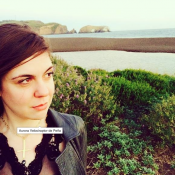You could say all theatre is experimental.
When a person takes their seat, they don’t know what’s going to happen, not really. Somebody could forget their lines, somebody could trip and fall, a truck might crash into the side of the building and have to be incorporated into the performance. Those things probably won’t happen, but they could. That’s what makes it tense; it’s live.
But because it’s live, theatre is a very careful thing. There are rehearsals, memorizations, Italians, walk-throughs, and fight calls. A fight call, while important, is a ridiculous looking thing. Watching actors not punch each other in slow motion is a rare, hilarious gift. I don’t know how they don’t crack up every time; oh wait, I do—it’s the endless repetition. We really are so cautious with each other. We take so much of our work so seriously. We treat the text in scripts with a sacredness the rest of the world reserves for funeral services.
Still somehow, the idea of experimentation is very close to the hearts of theatre makers. Back in January, Mark asked me to write about whether or not the words “Experimental Theatre” had lost their meaning. He’d been sifting through hundreds of Rhubarb applications, all claiming experimentation, some of which looked suspiciously like regular narrative plays with lines, plots and stage directions.
This past Rhubarb, I did a one-to-one performance. Unheard of for me, I kept telling Laura Nanni how experimental it was. She smiled graciously, said she was glad to help me explore new territory, then rattled off a list of things my collaborators and I might expect when sitting in a room alone with strangers in the context of performance. A veteran of this sort of thing, one-to-one was not an experiment for her. There were things to remember from the last 200 times.
Experimental theatre is as much about an experiment for the artist as it is an experiment for the art form.
This is a relatively un-shockable generation, audience wise. We’ve seen people drink their pee, we’ve been peed on, and one time I watched Keith Hennessy sew his skin to Rebecca Applebaum’s sweater after we’d all eaten chocolate he’d licked. We take it all pretty passively.
Okay, passive isn’t the right word, reverent is.
That reverence is incorruptible. At its heart, it’s protecting the magic we feel when making the abstract, deeply emotional connections experimental theatre often asks us to. That reverence protects us from derision, cuts to funding, and people telling us what we’re doing isn’t art. That reverence also relieves us from our regular catalogue of reactions; it’s hard to be complicit in experimentation when we respect the experimenters too much to ask questions.
I’m not talking about the questions you ask your friends after you’ve clapped politely and are having drinks. I’m talking about the questions that come from having expectations that are violated, the kind of questions you have to scream, questions that cause a riot.
I can’t imagine what it must have been like to be in the audience for the very first even opening night of Ubu Roi. How could a play take me by surprise and shock me so completely that I’d have to start a fight? In the theatre?!
Who remembers when Ulysses Castellanos, surrounded by de-capitated teddy bears and speaking in a really high voice, swung a live chainsaw by the cord above his head? It was a piece called Teddy Chainsaw Massacre at Rhubarb. I watched it from the catwalk with curator Alex Wolfson, who smiled benevolently and said something like, “This is so much more exciting than the two person narrative that’s happening in the cabaret,” while people fled from the audience amidst bits of flying polyfill and synthetic fur.
One of the repeated criticisms of Teddy Chainsaw Massacre was that he hadn’t prepared; no lines memorized, no action blocked. The thing was totally lacking in thoughtful craft, and if you believe thoughtful craft is at the heart of theatre, that’s a big problem. But we can’t deny that it was an experiment, and that it pushed those boundaries. It was far from sacred. I loved it, for the record, but I was really far from the chainsaw.
Of those careful pieces, those thoughtful pieces, those pieces that breed reverence, I think the experiment being conducted is quieter. It’s not always perceivable right away. Those pieces give me a new image, or a question, or if I’m lucky, a feeling.
I will not forget Heather Cassils laboured breathing after she’d finished with the clay; it was beaten and mis-shapen, but it was still clay. I was inexplicably angry, and it wasn’t my anger.
The sound of her breathing was a new feeling planted inside me, it was triumph, but with more work ahead.

